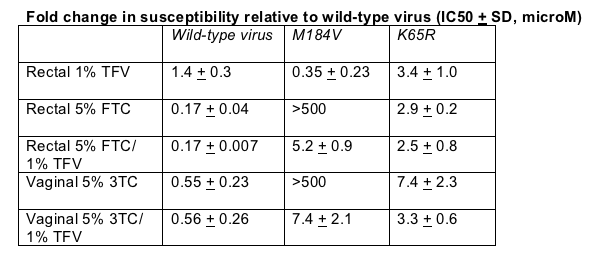| |
TFV/FTC and TFV/3TC Formulated into Vaginal and Rectal Gels
|
| |
| |
2nd International Workshop on HIV Transmission
August 26-28, 2007
Washington, DC
Mark Mascolini
Centers for Disease Control (CDC) researchers formulated tenofovir/emtricitabine (TFV/FTC) and TFV/lamivudine (3TC) into odorless microbicidal gels that stayed stable at room temperature for up to 6 months [1]. After recent failure of a much-touted cellulose sulfate microbicide candidate [2,3], the CDC work may signal a fresh start with antiretroviral-based microbicides.
Because TFV, FTC, and 3TC all have long half-lives, Urvi Parikh and CDC colleagues combined them in a pH 4.5 vaginal formulation and a pH 6.5 rectal formulation containing 5% (weight/volume) FTC, 5% 3TC, and 1% TFV, equivalent to doses of 200 mg/4 mL for FTC and 3TC and 40 mg/4 mL for FTV.
The CDC team then tested the gels against wild-type (nonmutant) HIV and against recombinant virus engineered to carry the M184V mutation (which confers resistance to FTC and 3TC) or K65R (which confers resistance to TFV). Earlier work showed that 1% TFV gel is safe and well tolerated for 2 weeks in women with or without HIV [4], but its protective power was not studied.
All three antiretrovirals retained antiviral activity in the gel formulation equivalent to their activity in water. Gels that combined two antiretrovirals had greater activity against M184V mutant virus than gels containing a single agent (Table). K65R had little impact on activity of the TFV-only rectal gel or the combination rectal or vaginal gels (Table).

Gel preparations remained stable for at least 6 months at room temperature, at least 3 months at 37C (99F), and at least 2 months at 50C (122F). Gel integrity began to degrade slightly after 4 months at 50C, but TFV did not degrade at any temperature or time point studied. FTC and 3TC underwent minor degradation after 6 months at 37C.
A cervical explant model showed little evidence of cytotoxicity after overnight exposure.
Parikh and colleagues suggested their study provides "promising evidence of the feasibility of using combination nucleosides in a topical intervention strategy for the prevention of sexually transmitted HIV infections."
References
1. Parikh U, Jia H, Sharma S, et al. Formulation and in vitro evaluation of FTC/tenofovir and 3TC/tenofovir microbicide gels. 2nd International Workshop on HIV Transmission. August 26-28, 2007. Washington, DC. Abstract 25.
2. Halpern V, Wang L, Obunge O, et al. Effectiveness of cellulose sulfate gel for prevention of HIV: results of the phase III trial in Nigeria. 4th IAS Conference on HIV Pathogenesis, Treatment, and Prevention. July 22-25, 2007. Sydney. Abstract WESS302.
3. Van Damme L, Govinden R, Mirembe F, et al. Phase III trial of 6% cellulose sulfate (CS) gel for the prevention of HIV transmission. 4th IAS Conference on HIV Pathogenesis, Treatment, and Prevention. July 22-25, 2007. Sydney. Abstract WESS301.
4. Mayer KH, Maslankowski LA, Gai F, et al. Safety and tolerability of tenofovir vaginal gel in abstinent and sexually active HIV-infected and uninfected women. AIDS. 2006;20:543-551
|
|
| |
| |
|
|
|